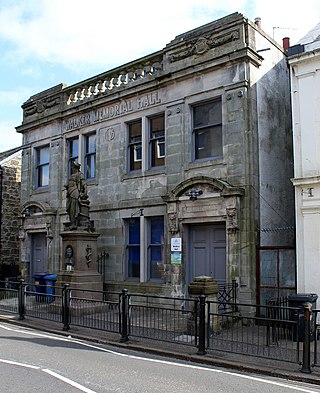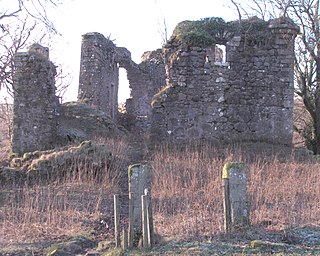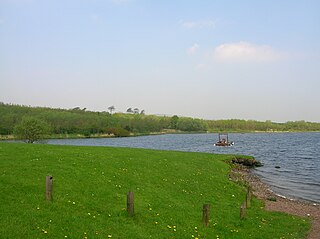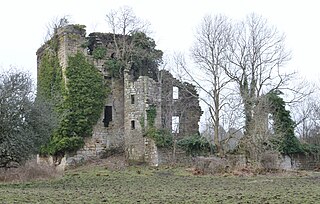Beith is a small town in the Garnock Valley, North Ayrshire, Scotland approximately 20 miles south-west of Glasgow. The town is situated on the crest of a hill and was known originally as the "Hill o' Beith" after its Court Hill.

Kilbirnie is a small town of 7,280 inhabitants situated in the Garnock Valley area of North Ayrshire, on the west coast of Scotland. It is around 20 miles (30 km) southwest of Glasgow and approximately 10 miles from Paisley and 13 miles from Irvine respectively. Historically, the town's main industries were flax production and weaving before iron and steelmaking took over in the 19th and early 20th centuries. The suburb of Kilbirnie in the New Zealand capital of Wellington is named after the town.
Glengarnock is a small village in North Ayrshire that lies near the west coast of Scotland. It forms part of the Garnock Valley area and is about 18 miles from Glasgow, the nearest city. The Barony of Glengarnock is one of three baronies which together form the parish of Kilbirnie in the district of Cunningham which lies in north Ayrshire. The River Garnock flows through the village, but the name Glen Garnock applies more specifically to the ravine at Glengarnock Castle, some 4 kilometres north of the village.

Bourtreehill House and the enclosed land on which it was built form the original estate of Bourtreehill. The wooded hill-top, a distinctive feature of the estate, is now a landmark that sits at the centre of modern North Bourtreehill in the district of North Ayrshire on the west coast of Scotland.

Captain Thomas Crawford or Thomas Craufurd (1530–1603) of Jordanhill was a trusted confidant of Henry Stuart, Lord Darnley, husband of Mary, Queen of Scots and a retainer of the Matthew Stewart, 4th Earl of Lennox. He famously planned the assault and led a small force of 150 men in 1571 that scaled the cliffs and embattlements to expel the castle garrison loyal to Catholic Queen Mary from Dumbarton Castle. Six years later, he became Provost of Glasgow, establishing a bursary for a student at the university and saving the cathedral from destruction.

Easter Greenock Castle was a castle of unknown design near the burgh of Greenock, Scotland.

Glengarnock Castle is one of the ancient ruined fortifications of Ayrshire. Its keep is located on a remote rocky promontory overlooking the River Garnock about 2 miles (3.2 km) north of the town of Kilbirnie in North Ayrshire, Scotland. There is no clear account of when this was erected or by whom, but it may have been built by the Cunningham family or by the Riddels who preceded them. The Barony of Glengarnock is one of three feudal baronies which together form the parish of Kilbirnie in the district of Cunningham which lies in north Ayrshire. The River Garnock flows through the village of the same name 4 kilometres (2.5 mi) to the south, but the name Glen Garnock applies more specifically to the ravine at Glengarnock Castle.

Clan Crawford is a Scottish clan of the Scottish Lowlands. The clan is of Scandinavian and Anglo-Saxon origin. There was in the early 18th century a mistaken belief that the clan had Norman origins. While historically recognised as a clan by the Court of the Lord Lyon, it is now an armigerous clan as it no longer has a chief. The last chief was Hugh Ronald George Craufurd, who sold his land and moved to Canada in 1904. He died in Calgary in 1942, leaving no male heirs.

The Barony of Ladyland was in the old feudal Baillerie of Cunninghame, near Kilbirnie in what is now North Ayrshire, Scotland.

The barony of Cartsburn in the Baronage of Scotland was created for Thomas Crawfurd of Cartsburn in 1669, when the lands of Cartsburn in the Parish of Easter Greenock in the Shire of Renfrew were erected in liberam baroniam, as a free barony held of the Prince and Great Steward of Scotland. The estate of Cartsburn, also known as Crawfurdsburn, incorporated the lands of Cartsdyke and part of the lands of Easter Greenock Castle. The Barony of Cartsburn is a feudal Barony of Scotland. The seat of the Barony was the House of Cartsburn, built in the 17th century near Greenock, Renfrewshire.

Kilbirnie Loch is a freshwater Loch situated in the floodplain between Kilbirnie, Glengarnock and Beith, North Ayrshire, Scotland. It runs south-west to north-east for almost 2 km (1.2 mi), is about 0.5 km (0.31 mi) wide for the most part and has an area of roughly 3 km2. It has a general depth of around 5.2 metres to a maximum of around 11 metres. The loch is fed mainly by the Maich Water, which rises in the Kilbirnie Hills near Misty Law, and is drained by the Dubbs Water that runs past the Barr Loch into Castle Semple Loch, followed by the Black Cart, the White Cart at Renfrew and finally the River Clyde. The boundary between East Renfrewshire and North Ayrshire, in the vicinity of the loch, runs down the course of the Maich Water along the northern loch shore to then run up beside the Dubbs Water.

Barkip, also known as The Den, is a hamlet in North Ayrshire, Scotland about three miles southwest of Beith on the A737 road to Dalry. The earliest recorded name is 'Blairkip'. In the Gaelic language, the name Barkip comes from bar ("top"), and kip. It is not clear when or why the name 'The Den' started to be used although it appears in the local press as both in 1898, however in Scots as in old English one meaning is 'A hollow between hills,' which is certainly an accurate description of the geography of the area that Barkip lies in. Following construction of a new road, Barkip no longer sits on the main Beith to Dalry road.

The remains of the old castle of Kersland lie about 1.5 miles to the north-east of the town of Dalry in North Ayrshire, Scotland, in the old Barony of Kersland. The River Garnock lies nearby.

The substantial remains of the old castle and sixteenth century manor house of Kilbirnie lie west of the town of Kilbirnie in North Ayrshire, Scotland, on the lower slopes of the Glengarnock Hills, in the old Barony of Kilbirnie. The building is also variously known as the Place of Kilbirnie, The Place, or Kilbirnie House.

The Barony of Glengarnock is a Scottish feudal barony in the county of Ayrshire in Scotland.

Fairlie Castle is a restored oblong tower castle located on a natural rounded knoll situated above a precipitous section of the Fairlie Glen near the town of Fairlie in the old Barony of Fairlie, Parish of Largs, North Ayrshire, Scotland. It was built by the now extinct family, the Fairlies of that Ilk and survives in a fairly good state of preservation. It is a protected scheduled monument.

The Old West Kirk of the Church of Scotland, authorised by a 1589 Royal Charter and first opened in 1591, is noted as the first Presbyterian church built in Scotland following the Scottish Reformation, and the first approved by the Parliament of Scotland. At an early stage, east and west aisles were added as transepts, giving the church its cruciform plan.
Robert Ker (the younger) (1634–1680) known as Robert Ker of Kersland was a Covenanter. He sympathised with the insurgents who fought at Rullion Green and consequently was declared a rebel and his lands became forfeit. He escaped to Holland but following his wife home on business he was captured while visiting her in her sick-bed in Edinburgh. He spent many years in various jails. He is remembered by Christian historians and biographers such as Wodrow and Howie as one who suffered for the Presbyterian cause in Scotland.

The Glencairn Aisle or Glencairn Vault at Kilmaurs, East Ayrshire is a Category B Listed vaulted sepulchral chapel built as a place for private contemplation and prayer that also contains a large memorial monument, as well as the burial crypt of the Cunningham Earls of Glencairn and their family members. An 'Aisle' is defined as a structure normally attached to a church, which may have burial crypt below, a family pew above, and sometimes a retiring room as at the Glencairn Aisle.

The Kennedy Aisle or Bargany Aisle at Ballantrae, South Ayrshire is a vaulted burial chamber and crypt containing a large mural memorial, the Kennedy Monument, an ornately carved stone monument dated to between 1602 and 1605 that commemorates Gilbert Kennedy of Bargany and Ardstinchar, his wife, Janet or Jean Stewart, who died in 1605 and three of their children.



























